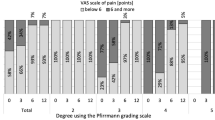Summary
Retrospectively 93 consecutive patients operated on for lumbar disc herniation were studied in order to evaluate the prognostic value of symptoms (lumbar pain and sciatica) and sick-leave. Surgical results were evaluated 1–3 years postoperatively by a questionaire. The duration of the present attack of sciatica and sick-leave prior to surgery was significantly longer in the group with unsatisfactory outcome compared to the group with satisfactory outcome. Patients with duration of the present attack of sciatica of less than 6 months had a significantly better result concerning outcome compared to patients with duration of 6–12 months and more than 12 months.
Patients who returned to the same type of work had a pre-operatively statistically significant shorter duration of present sick-leave, compared to the patients who had changed the type of work and the patients who did not return to work.
The patients with duration of their present sick-leave of less than 6 months had a significantly higher percentage of returning to the same type of work compared to patients with duration of their present sick-leave of 6–12 months and more than 12 months.
We conclude that the duration of sciatica and sick-leave before the operation has value as predictive factors concerning the over-all result after surgery for lumbar disc herniation.
Similar content being viewed by others
References
Abramowitz JN, Neff SR (1991) Lumbar disc surgery: the results of the prospective lumbar discectomy study of the joint section on disorders of the spine and peripheral nerves of the American Association of Neurological Surgeons and the Congress of Neurological Surgeons. Neurosurgery 29: 301–307
Barrios C, Achmed M, Arrotegui JI, Bjornsson A (1990) Clinical factors predicting outcome after surgery for herniated lumbar disc: an epidemiological multivariate analysis. J Spinal Disord 3: 205–209
Dvorak J, Gauchat MH, Valach L (1988) The outcome of surgery for lumbar disc herniation. A 4–17 years follow-up with emphasis on somatic aspects. Spine 13: 1418–1422
Dvorak J, Valach L, Fuhrimann P, Heim E (1988) The outcome of surgery for lumbar disc herniation. A 4–17 years follow-up with emphasis on psychosocial aspects. Spine 13: 1423–1427
Falc B, Nykvist F, Hurme M, Alaranta H (1993) Prognostic value of EMG in patients with lumbar disc herniation — a five year follow-up. Electromygr Clin Neurophysiol 33: 19–26
Finneson BE, Cooper VR (1979) A lumbar disc surgery predictive score card: a retrospective evaluation. Spine 4: 141–146
Haaland AK, Graver V, Ljunggren AE, Loeb M, Lie H, Magnæs B, Godal HC (1992) Fibrinolytic activity as a predictor of the outcome of prolapsed intervertebral lumbar disc surgery with reference to background variables: results of a prospective cohort study. Spine 17: 1024–1027
Herron L, Turner J (1985) Patient selection for lumbar laminectomy and discectomy with a revised obective rating system. Clin Orthop 199: 145–152
Herron L, Turner JA, Ersek M, Weiner P (1992) Does the millon behavioral health inventory (MBHI) predict lumbar laminectomy outcome? A comparison with the Minnesota multiphasic personality inventory (MMPI). J Spinal Disord 5: 188–192
Hurme M, Alaranta H (1987) Factors predicting the result of surgery for lumbar intervertebral disc herniation. Spine 12: 933–938
Lewis PJ, Weir BKA, Broad RW, Grace GG (1987) Long-term prospective study of lumbosacral discectomy. J Neurosurg 67: 49–53
Nachemson A (1969) Intradiscal measurements of pH in patients with lumbar rhizopathies. Acta Orthop Scand 140: 23–42
Nystram B (1987) Experience of microsurgical compared with conventional technique in lumbar disc operations. Acta Neurol Scand 76: 129–141
Spengler DM, Freeman CW (1979) Patient selection for lumbar discectomy, an objective approach. Spine 4: 129–134
Weber H (1983) Lumbar disc herniation a controlled, prospective study with ten years of observation. Spine 8: 131–140
Author information
Authors and Affiliations
Rights and permissions
About this article
Cite this article
Nygaard, Ø.P., Romner, B. & Trumpy, J.H. Duration of symptoms as a predictor of outcome after lumbar disc surgery. Acta neurochir 128, 53–56 (1994). https://doi.org/10.1007/BF01400653
Issue Date:
DOI: https://doi.org/10.1007/BF01400653




